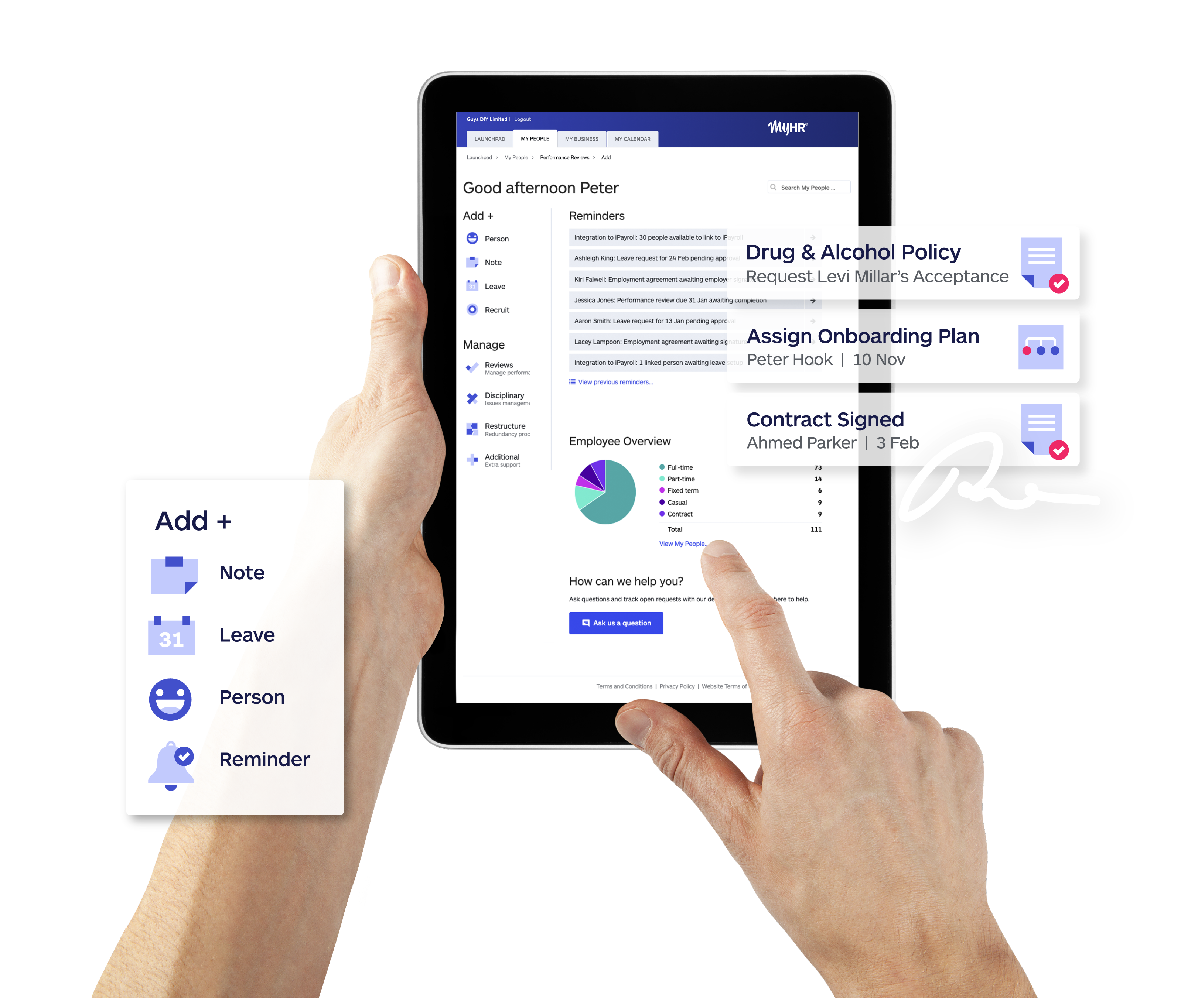
Having a team of high-performing employees is the goal for any organisation, and people typically want to be good at their job. But we all know that employee performance isn’t a static thing and can sometimes slip, whether that’s a slow slide in motivation or something more sudden.
Regular, informal feedback and coaching can generally deal with low-level employee underperformance, but sometimes the situation requires a formal performance management process.
This is where performance improvement plans (PIPs) come in. A PIP provides a formal and structured tool for improving substandard performance.
Like most situations in the employment relationship, undertaking a fair and full process is the key to achieving the best outcome - for you and the employee alike - while also minimising organisational risk.
This blog post explains what PIPs are, when you should implement them and how, and covers some important considerations when using them.
What is a performance improvement plan?
A performance improvement plan is a structured process designed to correct poor performance.
PIPs are agreed to by both the employer and employee and typically consist of 5 main elements:
- Purpose - what you are trying to achieve and why.
- Background - what you have provided in terms of support and informal coaching to date.
- Objectives - clear, concise, time-bound goals for improvement.
- Steps for supporting improvement, e.g. further training or changes to duties.
- Timeframes - fair and reasonable junctures for performance check-ins.
You should work with your employee to tailor the PIP to their needs and the best way for them to work successfully as part of the team. The PIP should also document the potential consequences if performance doesn’t improve, e.g. disciplinary action or termination.
Why put an employee on a PIP?
If an employee isn’t meeting performance expectations it’s important to address this before the problem gets so bad you have to look at terminating employment.
A PIP is a good place to start formal performance management to get the person back on track. This will typically be part of the support you provide as part of the disciplinary process or it may come as a step before the issue calls for disciplinary action.
Be aware that PIPs are not the correct response to instances of misconduct e.g, timekeeping or attendance to work, inappropriate language or behaviour, insubordination or serious misconduct such as sexual harassment, bullying, theft, being intoxicated at work. Serious matters that significantly damage the trust and confidence in the employment relationship require immediate disciplinary action.
Done well, PIPs are effective at bringing an issue to the attention of the employee, detailing the reason for the necessary improvement, and advising them of potential outcomes for not meeting expectations, e.g. their employment may be terminated
PIPs also provide proof that the business has acted fairly in making efforts to address poor performance with the employee and that you have given them a reasonable opportunity and support to improve. This helps reduce legal risk if you end up at termination and are challenged, e.g. the employee lodges an unfair dismissal or general protections claim.
Steps for setting up a performance improvement plan
A PIP is a clear agreement between the organisation and employee regarding the required improvement, setting clear objectives that the person is required to meet, and the support and training the company will provide.
It is essential to ensure 2-way communication lines are open with the employee because the process requires their input and they need to commit to improving.
A PIP process will typically involve:
Drafting the PIP
You may need some time (and support) in creating the PIP so it is clear and concise.
A PIP is a tool to capture the discussion you’re about to have with your employee so you will want it to cover all the different parts of the meeting. Depending on the topic and number of performance issues, the content of a PIP can vary in size and complexity.
For example, if the issue is not meeting sales targets, the plan may simply be to reduce their target temporarily for a week (or month if they are working towards monthly targets) and providing further training to ensure they fully understand your product or service.
On the other hand, for more ingrained problems, you may need a longer, more detailed PIP. For example, if the warning is for poor overall work performance, the plan may include some extra training and a review meeting each week for 2 months to provide additional support and guidance.
You should also include reasonable timeframes, cadence for regular follow-up meetings, any training or support they need, how performance will be reassessed at the end, and potential management action for not achieving, e.g. a second or third PIP or termination of employment at the end of this process.
MyHR’s expert advisory team has created PIPs for thousands of employees. If you need any help writing and implementing your performance processes, don’t hesitate to reach out.
Meeting with the employee
This is the time to clearly explain your concerns to the employee and provide examples of how the issue causes problems for other people and the overall business. Describe what you want to be different and what success looks like.
This is a dialogue, so you need to ask for the employee’s feedback. They may have a fair and reasonable explanation, or they may give you information that you didn’t know. Alternatively, they may complain or not have a good explanation at all.
Discuss what will happen next and that you would like to implement a PIP to support the improvement in their performance.
Provide the employee with the PIP in draft format in order to agree on specific and realistic objectives, e.g. they will slow their input to ensure accuracy or they will be more proactive about finding work to do on their shift. Allow time for the person to take the draft away, review it, seek advice, and provide feedback. You may need to make some changes to take on board their feedback before you both agree to implement the PIP.
Implementing the PIP
Once you have the PIP up and running, be sure to follow all agreed actions. Get together regularly for scheduled review meetings (along with less formal catch-ups) to support the employee, keep track of their progress, and give them specific feedback.
It is crucial you do all the things you have committed to in the PIP, in order to demonstrate you have done all you can as a fair and reasonable employer to support their improvement.
Make notes as you go, when additional support and training was provided, and how the employee is tracking towards the objectives. Include details of progress meetings and issues discussed. Also, give the employee a copy for their records.
Final review and outcome
At the end of the PIP period, review the employee’s performance against the agreed actions. If their performance/behaviour has improved, great! Let them know that this process has concluded.
If they haven’t shown the required improvement, you can look to potentially implement a second PIP (if you feel they will reach their objectives with a bit more time and support).
Performance improvement plan template
The exact makeup and length of a PIP will depend on the complexity of the issue and what areas the employee needs to improve.
An effective plan will clearly define:
- Areas for improvement.
- Constructive, measurable goals.
- How objectives will be tracked.
- Support and training needs.
- Realistic timeframes.
- Next steps.
A PIP also allows plenty of opportunities for the employee to respond to each of these topics and provide their input and reflections.
MyHR has years of experience helping organisations with PIPs, from drafting robust plans to supporting employers with advice and implementation.
Download our free guide to creating PIPs.
Considerations before putting an employee on a PIP
If you decide a performance improvement plan is the best option, to maximise its effectiveness you need to ensure that it includes activities, key milestones, and any support you will provide.
The objectives should be SMART: specific, measureable, achievable, realistic, and timebound. This ensures there is no ambiguity when it comes to measuring whether the employee has achieved the objectives or not.
You also need to make sure the employee understands the consequences of failing to improve, e.g. further disciplinary action or termination.
Give the employee plenty of opportunity to demonstrate they can improve. Be realistic about the speed of change and do everything you can to support improvement, with guidance, counselling, training, and regular check-ins.
Make sure you deliver on your actions as the people leader and do whatever you say you will. Remember, a PIP does not replace giving verbal feedback on the spot, or managing your team as usual. Make sure you keep talking to the person throughout the process.
Also bear in mind that the employee has the duration of the PIP to lift their performance, so if they fail to meet the objectives in first or second week of a 4-week PIP, we wouldn’t recommend taking disciplinary action for that failure, but rather to wait until the end of the PIP to evaluate progress.
Always document and securely store the PIP (this is much easier if you use a digital platform like MyHR). The PIP records the business’ efforts to obtain improvement and the employee’s corresponding efforts. If you are challenged later on - e.g. the employment relationship deteriorates and the employee raises a claim - PIPs provide proof you gave the employee fair and reasonable opportunity and support to meet expectations.
Can an employee refuse to agree to a PIP?
From time to time an employee may refuse to engage in a PIP, as they feel there is nothing wrong with their performance. Their refusal to engage doesn’t translate to you not being able to implement a PIP, but it may complicate the process.
Ensure you understand - and have a record - of the employee’s reason(s) for refusing. Take this into consideration: are you confident they understand the intention of the PIP is to support their improvement? Are the objectives realistic, or can you reach a compromise?
If there are no options but to proceed with the PIP, make it clear that continued refusal to engage may translate to failure to follow instruction and therefore become a disciplinary matter in its own right.
Caution when using PIPs - due process
There are legal risks to implementing a PIP without due process, especially if you end up dismissing the employee for not achieving the objectives, as you haven’t documented continued poor performance issues and formally raised them.
Process is always important, from providing notice for a formal meeting, inviting the employee to bring a support person, the opportunity to reflect on the process after the meeting and provide any further input, to providing the employee with a copy of the PIP for their review and confirmation.
How long should a PIP be?
The length that a PIP is in place varies, and is connected to the plan’s objectives.
The timeframe provided should reflect a fair and reasonable time for the employee to be able to receive training and support, and to lift their performance or change behaviour.
We generally recommend a period of up to 4 weeks, however, if performance relates to a longer project, it may be appropriate to extend the PIP for the duration of the project.
We also recommend regularly checking in with the employee to see how they’re tracking toward the objectives. Weekly check-ins would be appropriate for a PIP that is up to 4 weeks long.
Are there other options?
Using regular, informal check-ins combined with a robust performance review system is essential for developing and maintaining productive relationships with your people.
Set clear performance expectations during onboarding and establish open, honest dialogue so both parties can raise problems and work on developing and implementing solutions.
If you notice an employee is struggling to meet expectations, don’t delay in dealing with the issue. If you need to escalate matters, be sure not to make decisions or blaze into the process without recognising your obligations. If you need expert advice, MyHR is just a click or phone call away.
I’m feeling nervous about this as a people leader, what can I do to prepare?
Managing employee performance can be complicated and you may feel anxious about raising problems with your employees. Here are some resources that will help you approach any issue with confidence and get the best outcome for the business and your team members:
- Having difficult conversations at work - we explore tough workplace situations that people often avoid and ways to turn difficult conversations into courageous ones.
- Leadership: Developing your fundamental skills - expert insights into the relationship between good leadership and team performance, and leadership training tips.
- How to manage employee performance and development - we get to the bottom of high-performance work cultures, how to build them, and foster talent development.
- How to deal with employee underperformance - advice on how to separate unsatisfactory employee performance from misconduct as well as trusted tools and techniques for addressing underperformance.
- Building resilience in your workplace - we look at ways business leaders can support employee wellbeing and build an open and supportive company culture.




